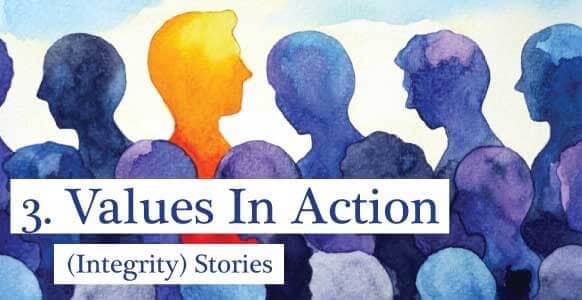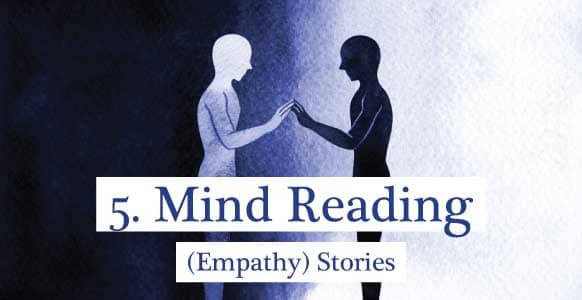
Hypnotic storytelling involves telling hypnotic stories as part of a hypnosis session.
Simple enough, right? But why tell stories in the first place?
Well, hypnotic storytelling serves a whole bunch of different purposes.
Hypnotic stories in general are a great way to bypass your subject’s critical factor.
They also help to stimulate the imagination and make it easier for people to switch off from the everyday conscious world.
In other words, hypnotic stories can provide you with a quick and simple way to put someone into a hypnotic trance.
But what types of stories work best? And under which circumstances should you use them?
Below are 6 of the most influential types of hypnotic stories and some tips on when you should use them to build trust, induce a hypnotic trance and put your subjects at ease.
1. Who Am I (Connection) Stories To Build Trust

If you want to hypnotize someone, you have to be able to connect with them. That’s another way of saying that you need some kind of rapport.
Hypnosis is a form of communication between two people. Before you can work with your client or subject, however, they have to be able to relate to you. And they’ll be able to relate to you once they understand that you’re a human being just like they are.
You’ve got motivation. You’ve got things you aspire to. You’ve got things you enjoy and things you like to do regularly. You’re not just a hypnotist or hypnotherapist, but also someone with a whole other life behind them.
So you might share something about yourself. Maybe something small like how you watch your children sleep, or something big like when you saw them being born. Or you can share any other moment that gives them some idea about who you are.
The point is that you need to connect with your clients or subjects. Once you’ve made a connection, then they can relax and feel like they’re able to trust you. You’re one of them. And when they feel they can trust you, that’s when you have the power to influence them.
2. Why Am I Here (Trust) Stories

Once you get someone to relate to you, then you need to satisfy their curiosity about another aspect. And that is: why are you here?
In order for them to really trust you, they need to know what motivates you. What are you getting out of the interaction? Why are you doing hypnosis?
If you told them you were a hypnotist just to make a few extra bucks, it’s not your main job but something you do on the side, then the message you’re sending is that profits are more important than people. Chances are, they won’t schedule another appointment after this disclosure!
If you told them that you experienced the benefits of hypnosis in your own life and wanted to help other people in the same way, then they’d probably feel more inclined to trust you and work with you.
People will understand that you need to make a living. But if you can convince them that your motivation is to help them lead better lives, then they’ll take it for granted that you need to earn money as well. And that means they’ll be able to relax and put their trust in you.
For example, imagine two police officers walking the beat. One is motivated by the desire to serve the public and to keep the streets safe in the neighbourhood. The other one became a policeman because it was a respectable job with a good pension. Knowing what motivates them, you’d probably interact with each of them in a slightly different way.
3. Values In Action (Integrity) Stories

Another thing your stories can demonstrate is integrity. That’s important, because people need to know that you are honest and trustworthy.
Imagine a salesperson who sends a customer to a rival dealer because they have exactly what the customer is looking for. That’s integrity. The salesperson is willing to lose the sale in order to do the right thing by the customer.
There’s a similar scene in the 1994 remake of Miracle on 34th Street, where Cole’s Santa Claus sends customers to other toy stores where products are less expensive. At first the staff at Cole’s are outraged, but then they realize what a great idea this is. It demonstrates integrity to customers, who value it and subsequently vow to keep coming back.
So what about your story? There may have been a time when you felt that hypnosis was not the right option for a specific client. Rather than just taking their money and going through the motions, you came clean. Perhaps you even recommended another type of therapy or therapist. Again, that’s integrity, putting the client first, ahead of the almighty dollar.
4. Teaching Tales

There are loads of fantastic teaching tales told by the late and great Milton Erickson. Similar tales can be found in Christian parables and Sufi stories.
Teaching tales tend to contain some kind of moral or lesson, a lot like Aesop’s fables. The following story is an example of a teaching tale, one that appears in a few different guises depending on who’s telling it.
The monks walked on in silence, but the younger man was fuming. Finally, he blurted it out:
‘Why did you help that woman when you know it’s against our code of conduct?’
The older monk replied: ‘I set her down hours ago, so why are you still carrying her?’”
In this story, carrying something physically acts as a metaphor for carrying something emotionally.
One terrific way to come up with a teaching tale is to think about something that happened to you. You could talk about an experience you had where you made a mistake or struggled with something, and then explain what you did to resolve the situation.
Teaching tales can be personal examples, or they can be examples from history or literature. They can also be humorous stories, and you can tell them from a third person’s point of view, such as the “my friend John” story type.
These kinds of stories achieve a number of different goals: they help your clients relate to you and they help you establish a connection. They also give you a way to “teach” a lesson without getting too preachy, by disguising the lesson in an interesting story.
5. Mind Reading (Empathy) Stories

These are stories that let other people know you understand their situation, that you acknowledge their pain, and that you understand the difficulty of a particular context, situation or challenge they face.
Mind reading stories demonstrate that you can put yourself in other people’s shoes and can appreciate things from their point of view.
For example, imagine a hypnosis client refusing to close their eyes and relax. That would create a huge stumbling block for you. But you could easily get around it by saying, “I know exactly how you feel because” (and then tell a relevant story from your own experience) or “I don’t blame you for hesitating because” (and then tell your relevant story).
The idea is not to fight with the person to try and make them fall in line, but to empathize with them. It’s using the carrot instead of the stick because you want them to agree to hypnosis voluntarily.
6. Transformational Stories

You probably realize that the word “transformational” can be applied to the change work element of a hypnosis session. That’s where you could use your storytelling skills to help someone access their internal resources and make subtle changes in their life. And you’d do that by wrapping your transformational story up in an induction.
For example, your client might be struggling to learn something new. As part of your induction you would begin by getting them to relax and focus inside. Then you might tell them a story about how all the things they’re learning are floating around inside their head, just waiting to come together and make sense.
Next you could lead them to a special place – like a room, a landscape, a dreamscape, or anywhere suitable – where a path will take them to a doorway. Going through the door they will discover something important of value to them, something that can help them move forward with whatever they’re trying to do.
Important Tips On How To Remember Stories!
One of the easiest ways to remember a story is to relate it to something else, something like an icon, a person, a place, or anything that brings it back into your mind.
For instance, The Lord of the Rings is a story about a ring.
Star Wars is a story about space.
The Ugly Duckling is a story about a duck who isn’t really a duck but is actually a swan. You might recognize this as both a teaching tale and a transformational story. And you can remember the story easily enough by conjuring up an image of a duck or a swan, whichever works best for you.
Remember the story about the monks, the river and the woman? Just saying “the two monks” should be enough to remind you about that story.
Think about the stories you tell and try to come up with a word, an icon, a person or anything else that reminds you about them. Then whenever you want to retell the story, that word, icon, or person will be enough to bring it all back.
You can take things further to make remembering them even easier. This will help you as your list of stories grows longer and longer. The idea is to put the words/icons/people in a specific location in a particular room.
Mentally think of a room (such as the kitchen) and imagine your icons in certain locations. There’ll be an image conjured up by the knife drawer, another in the fridge, another on top of the microwave, and so on.
Map out the position of your story ideas, repeat the process several times, and keep repeating it until the stories and their locations are locked inside your mind. If you need to expand the concept further to accommodate even more stories, simply go to another room and start over.
To conclude..
Once you get into the swing of storytelling, you’ll naturally start listening out for stories told by other people. You’re bound to hear stories that you can borrow or adapt to fit your own circumstances, and then you can tell those stories and put your own personal spin on them.
That’s one of the ways that stories grow, and one of the ways in which stories constantly change and evolve.
You hear stories and share them with others, adapting them to fit the people listening and the situation they find themselves in. It’s like you’re wrapping the story up in a different cloak to give it a fresh new look, although the underlying gist of the story will remain essentially the same.









![Yogic Breathing For Hypnosis: 3 Easy Techniques To Ground & Relax Your Clients Before Inducing A Hypnotic Trance [Includes Infographic] Yogic Breathing For Hypnosis: 3 Easy Techniques To Ground & Relax Your Clients Before Inducing A Hypnotic Trance [Includes Infographic]](https://hypnosistrainingacademy.com/wp-content/uploads/2019/05/yogic-breathing-for-hypnosis.jpg)



![[ADVANCED GUIDE] How To Master Hypnotic Regression Therapy - Part I: Essential Principles To Profoundly Transform Your Subject’s Emotional Trauma [ADVANCED GUIDE] How To Master Hypnotic Regression Therapy - Part I: Essential Principles To Profoundly Transform Your Subject’s Emotional Trauma](https://hypnosistrainingacademy.com/wp-content/uploads/2016/09/hypnotic-regression-therapy-essential-principles.jpg)
